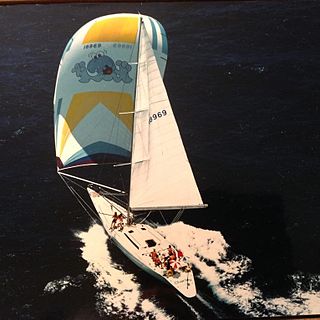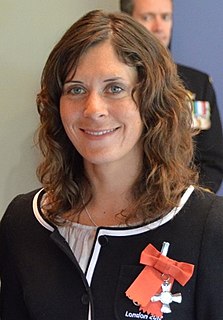Idle-Along| Development |
|---|
| Designer | Alf (Unc) Harvey |
|---|
| Location | Wellington, New Zealand |
|---|
| Boat |
|---|
| Crew | 3 |
|---|
| Hull |
|---|
| Type | Monohull |
|---|
| LOH | 12 feet 8 inches (3.86 m) |
|---|
| Beam | 6 feet (1.8 m) |
|---|
| Sails |
|---|
| Upwind sail area | 160 square feet (15 m2) |
|---|
Idle-Along (IA) - is a class of sailing dinghy (or small centreboard yacht) designed by Alf (Unc) Harvey at Petone (Wellington, NZ) in 1927. It grew to considerable popularity in the 1950s but its popularity gradually diminished during the 1960s. A redesigned hull for plywood construction by John Spencer kept the class going but on a smaller scale with a small revival in the 1990s with about 10 new boats being built. The Idle-Along is also sometimes referred to as IdleAlong, Idle Along, IA, I Class and Idie.

A dinghy is a type of small boat, often carried or towed for use as a lifeboat or tender by a larger vessel. The term is a loanword from the Bengali ḍiṅgi, Urdu ḍīngī & Hindi ḍieṁgī. Utility dinghies are usually rowboats or have an outboard motor, but while some are rigged for sailing, they are not to be confused with sailing dinghies which are designed first and foremost for sailing. Dinghies' main use is transfers from larger boats, especially when the larger boat can't dock at a suitably-sized port or marina.

Plywood is a material manufactured from thin layers or "plies" of wood veneer that are glued together with adjacent layers having their wood grain rotated up to 90 degrees to one another. It is an engineered wood from the family of manufactured boards which includes medium-density fibreboard (MDF) and particle board (chipboard).
The premium annual trophy for the Idle-Along was the Moffat Cup - which was first sailed for in 1936. The Moffat Cup was revived in 2010 at Birkenhead and sailed again in 2011 in the Bay of Islands. The 2012 Cup was to be sailed in Taupo but economic pressure has seen the race re-scheduled to Auckland as the Alf Harvey Memorial Regatta.
The Idle-Along is 12 foot 8 inches long plus bow sprit and 6-foot (1.8 m) in the beam and carries 150 sq ft (13.9 m2) of sail plus spinnaker.

A spinnaker is a sail designed specifically for sailing off the wind from a reaching course to a downwind, i.e. with the wind 90–180° off bow. The spinnaker fills with wind and balloons out in front of the boat when it is deployed, called flying. It is constructed of lightweight fabric, usually nylon, and is often brightly coloured. It may be optimised for a particular range of wind angles, as either a reaching or a running spinnaker, by the shaping of the panels and seams.

Yachting refers to the use of recreational boats and ships called yachts for sporting purposes. Yachts are distinguished from working ships mainly by their leisure purpose.

Dinghy sailing is the activity of sailing small boats by using five essential controls:

The Optimist, also known as the ‘opti’, 'oppie' or 'bathtub', is a small, single-handed sailing dinghy intended for use by children up to the age of 15. Contemporary boats are usually made of fibreglass, although wooden boats are still built.

Ronald John Holland is a yacht designer, who came to prominence in the 1970s with his successful racing designs, and is now best known for his superyachts such as Mirabella V and Ethereal. He is now based in Vancouver, British Columbia, Canada.

The Moth Class is the name for a small development class of sailing dinghy. Originally a cheap, home-built sailing boat designed to plane, now it is an expensive and largely commercially-produced boat designed to hydroplane on foils.

The RS300 is a modern racing sailing dinghy made by RS Sailing. The RS300 is a one-design, single-handed, hiking dinghy with a PY of 972. Designed by Clive Everest and first produced in 1998, it is inspired by the International Moth, of which Everest was a successful designer.

The Cherub is a 12 feet long, high performance, two-person, Planing dinghy first designed in 1951 in New Zealand by John Spencer. The class is a development class, allowing for significant variation in design between different boats within the rule framework. The minimum hull weight was originally 110 lbs.
Zeddie is an old New Zealand sailing dinghy. The first boat was designed and built by Mr R.B. Brown at Northcote in the 1920s. The Zeddie originally was gunter rigged, which shortened the spars for convenience. Some have been converted to Bermudan, no jib and a spinnaker which was sheeted around the front of the mast leading to many capsizes. This rule was changed in the interests of safety. The Zeddie is 12 foot 6 inches long and about 5 foot in the beam.

There are three designs of Phantom sailboats, one is a small una rig which is often raced, another is a lateen rig that was designed after the Sunfish model sailing dinghy, and a third is a larger keelboat designed and built in Sydney, Australia.

The Starling is a New Zealand 9-foot-6-inch (2.90 m) sailing dinghy designed by Des Townson.

The Louis Vuitton Pacific Series was a match race regatta in America's Cup Class yachts in Auckland, New Zealand during January and February 2009. Racing started on 30 January. The Louis Vuitton Pacific Series was organised in association with the New Zealand Government, Emirates Team New Zealand, the Royal New Zealand Yacht Squadron, Auckland City and Skycity Entertainment Group. Bruno Troublé was Louis Vuitton's organizer and spokesperson for the Series.
Desmond Thomas Townson was a New Zealand yacht designer. As a teenager he won the Tanner Cup in 1950, the nation's premier teenage yachting championship and he designed some of the best-known classes in New Zealand sailing; including the Starling, Zephyr Mistral and Dart dinghy classes.
The Louis Vuitton Trophy Auckland was the second in a scheduled series of regattas that compete for the Louis Vuitton Trophy. The regatta was held in Auckland between 7–21 March 2010. The Louis Vuitton Trophy format uses existing International America's Cup Class yachts loaned to the regatta by various America's Cup racing syndicates, keeping costs low for the competing teams.
RS Sailing is an international designer, builder and supplier of sailboats and dinghies and associated goods and services supported by a worldwide dealer network and class associations.

Peter Burling is the 2017 America's Cup champion helmsman, and an Olympic gold and silver medallist.

Joanna Ayela Aleh is a New Zealand sailor. She is a national champion, a former world champion, and an Olympic gold medallist.

Andrew Blair Tuke is a New Zealand sailor who won the gold medal at the 2016 Summer Olympics, and the silver medal at the 2012 Summer Olympics in the 49er class alongside Peter Burling.

The Javelin is a high performance skiff type dinghy sailed in Australia and New Zealand. The class was founded by designer John Spencer in 1961. Spencer also founded the Cherub Class. It is 14 feet long, sporting a large sail area, single trapeze and asymmetrical spinnaker. The Javelin is a development class, meaning that boats vary in shape within a framework of rules, rather than being all built to the same design. Bruce Farr is another well known designer who drew successful Javelins.

The Weta 4.4 Trimaran is a 4.4 metre sailing dinghy conceived and developed in New Zealand from 2001-2006 by Roger and Chris Kitchen and others with original drawings by TC Design's Tim Clissold.

The Farr 3.7 is a one-person sailing dinghy designed by Bruce Farr in 1971. The design plans are sold by the 3.7 Class Owners Association and they are built by a mix of professionals and home built by amateurs. The 3.7 Class is recognised by Yachting New Zealand as a national class and yachts are sailed in New Zealand, Australia and Great Britain. Full sets of plans have been sold worldwide to a number of individuals with greatest numbers in Germany, Japan, USA, South Korea, Poland, France, Belgium.


















